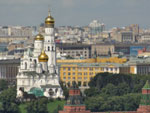 |
| source: mosday.ru |
In the center of the Kremlin's Cathedral Square stands the miracle of architectural art of the 16th century, Ivan the Great Bell Tower. It combines all the ancient temples of the Moscow Kremlin in a single architectural complex. Besides, this tallest building of the Kremlin is the spokesman of the might and power of Moscow. The giant white stone “pillar of fame” towering above the Kremlin hill told anyone who approached Moscow, about the greatness of the Russian capital.
This masterpiece of the Kremlin architecture was built on the site of the old stone Church of John Climacus in 1508 by Italian architect Bon Fryazin. In 1532 another Italian architect, Petrok Maly, added the belfry intended for the huge 16-ton bell.
In 1552, the third tier of the belfry was added with an outer staircase, and the belfry itself – with domed drum. In 1600 Boris Godunov started a major restructuring of the bell tower making it two levels taller. The lower floor of the bell tower was re-established as the temple of the Saint John Climacus. That is why the bell tower was called Ivan (John) the Great. After the reconstruction the tower reached the height of 81 m. It used to be the watching and signal tower since the watchmen could see as far as 30 km.
In 1624 the north side of the belfry was used by Bazhen Ogurtsov, who erected the so-called Philaret outhouse culminating it with white stone pyramids and tiled hipped roof. The second and third floors were intended for the patriarchal sacristy.
Ivan the Great Bell Tower is a three-tiered tower of elongated tapered upwards octahedrons one above another. Each octahedron has a terrace and an open gallery with bells. The bells themselves are the remarkable monuments of Russian foundry art of the 16th – 19th centuries. There 21 of them. All the bells are decorated with ornaments, bas-reliefs and inscriptions, which refer to the history of the bells, the date of casting, the weight, and the maker. The largest bell, Dormition, weighs 70 tons. It was cast in the 19th century. Another bell, weighing 19 tons, was cast in 1622. The Filaret outhouse has the bell weighing 12.5 tons cast in the 18th century. In 1812 Napoleon's troops, retreating from Moscow, attempted to blow up the bell tower. It survived, but the belfry and Philaret outbuilding were destroyed. In 1819 they were restored by the architect Gilardi; however, he used some elements of the 19th - century architecture. Next to the bell tower stands the Tsar Bell, the masterpiece of casting art. Its surface is decorated with beautiful relief ornamentation.

